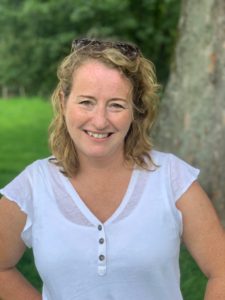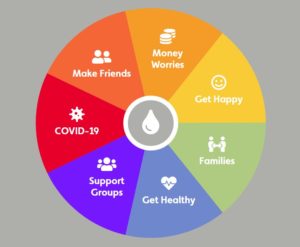 ‘I have been a nurse for 21 years and this year I am proud to have been awarded the title of Queen’s Nurse. I trained in Yorkshire before moving to Canada and working as both a surgical and ER nurse there for two years before securing work on a cruise line. I nursed on lots of the biggest and smallest ships in the fleet for about a year before moving back to the UK. Once back on home soil I worked for a very short time in a pharmaceutical company before returning to proper nursing. I worked as an agency nurse in many of the A&Es in London for a year or so. My final shift was in St Mary’s on the day of the London bombings. I walked away that day knowing for certain that A&E was not for me. It was then that I found my passion in community nursing. I worked with district nursing teams in Notting Hill before accepting a job indoors and becoming a Practice Nurse. I loved the job and from there I decided that it was time to get serious about my career and did a degree in Advanced Practice at King’s. So now I find myself in the best job yet.’
‘I have been a nurse for 21 years and this year I am proud to have been awarded the title of Queen’s Nurse. I trained in Yorkshire before moving to Canada and working as both a surgical and ER nurse there for two years before securing work on a cruise line. I nursed on lots of the biggest and smallest ships in the fleet for about a year before moving back to the UK. Once back on home soil I worked for a very short time in a pharmaceutical company before returning to proper nursing. I worked as an agency nurse in many of the A&Es in London for a year or so. My final shift was in St Mary’s on the day of the London bombings. I walked away that day knowing for certain that A&E was not for me. It was then that I found my passion in community nursing. I worked with district nursing teams in Notting Hill before accepting a job indoors and becoming a Practice Nurse. I loved the job and from there I decided that it was time to get serious about my career and did a degree in Advanced Practice at King’s. So now I find myself in the best job yet.’
I have always loved my job as an ANP in Primary Care, it comes with its own challenges and frustrations, but I love the nuts and bolts of the job. The autonomy in making decisions about my patients care took some getting used to and I love the relationships that are forged over years of working in one community. The training to become an ANP involved lots of training in things like pharmacology and assessment skills. However, very often my patients do not need a prescription for medication, investigations or an onward referral. Often their health would be improved if they had help with organising their finances, support for their mental health, a way to increase their social connection or easy access to a food bank. This sort of help is known as Social Prescribing and over the last couple of years it has become a central part of the job.
However, access to information about where the local or national services are has been tricky. There are online and paper directories from all kinds of sources, but no central point of access.
A few months ago this problem presented itself in a very real and immediate way. I sat looking at my patient whose physical problems clearly started with the fact that she was hungry. She had no way of getting to the closest food bank and no way of even finding out where it was or when it opened.
There have been a few times in my life when I feel that I have no choice but to address a problem head on, and this was one of them. Of course I organised immediate help for my patient, but I also set about fixing the more pressing issue. This village urgently needed a food bank. I was instrumental in getting one off the ground and today it helps many people each week.
But I was still bothered by the deeper problem. Why had things got so bad, why had my patient got into such a position when she had to choose between heating or eating? I knew of various agencies which might have been able to help, but my patient had no idea about them. Why was there no simple way for her to access support and information. And why did patients have to wait for months to see a Social Prescriber in order to find the help they urgently need?
During national lockdown I set about developing a simple digital platform which essentially cuts out the middle man. My patients can now go directly to www.treacle.me and find all the information they need without waiting to see a social prescriber. Of course social prescribers do so much more than simply act as sign posts, but giving patients access to information is a good start. It is essential too, as at the time the social prescriber in my practice had closed her list as she was so overwhelmed by demand.
I passionately believe that social prescribing should not simply be a different arm of health care; just another referral to do, or an alternative place to send our patients for a different sort of care. Rather that social prescribing should be an integral part of every consultation; that the patient’s needs beyond their sore throat or skin rash should be addressed as simply as possible within the consultation.
Obviously there are a number of barriers to this being possible. Time, the depth of the relationship with the clinician, and access to the information all act as stumbling blocks. www.treacle.me cannot solve all these problems, but it does address the issue of access to information. Rather than tasking someone else in the organisation, or hunting for a bit of paper with a local groups info, or even doing an online search trying to find the right website to help an anxious teenager, a hungry mum or a lonely old man, clinicians can now go straight to Treacle, tell the patient how to do the same, then in two clicks find the resources they need.
This is a very simplistic view of what is obviously a huge topic. However pulling down one barrier in this process is a step in the right direction for our patients. It may simply be that putting the patient in contact with the organisations that can help them may simply buy some time whilst they wait for an appointment with a social prescriber, which realistically could be weeks or months away. Putting the information straight into the hands of the patient gives them some power back and crucially takes it away from medical services. In these ever changing times, putting information directly into the hands of people that need it most might just reduce some of the demand on primary care which as we all know, is already stretching at the seams.

Helen O’Connell, Queen’s Nurse